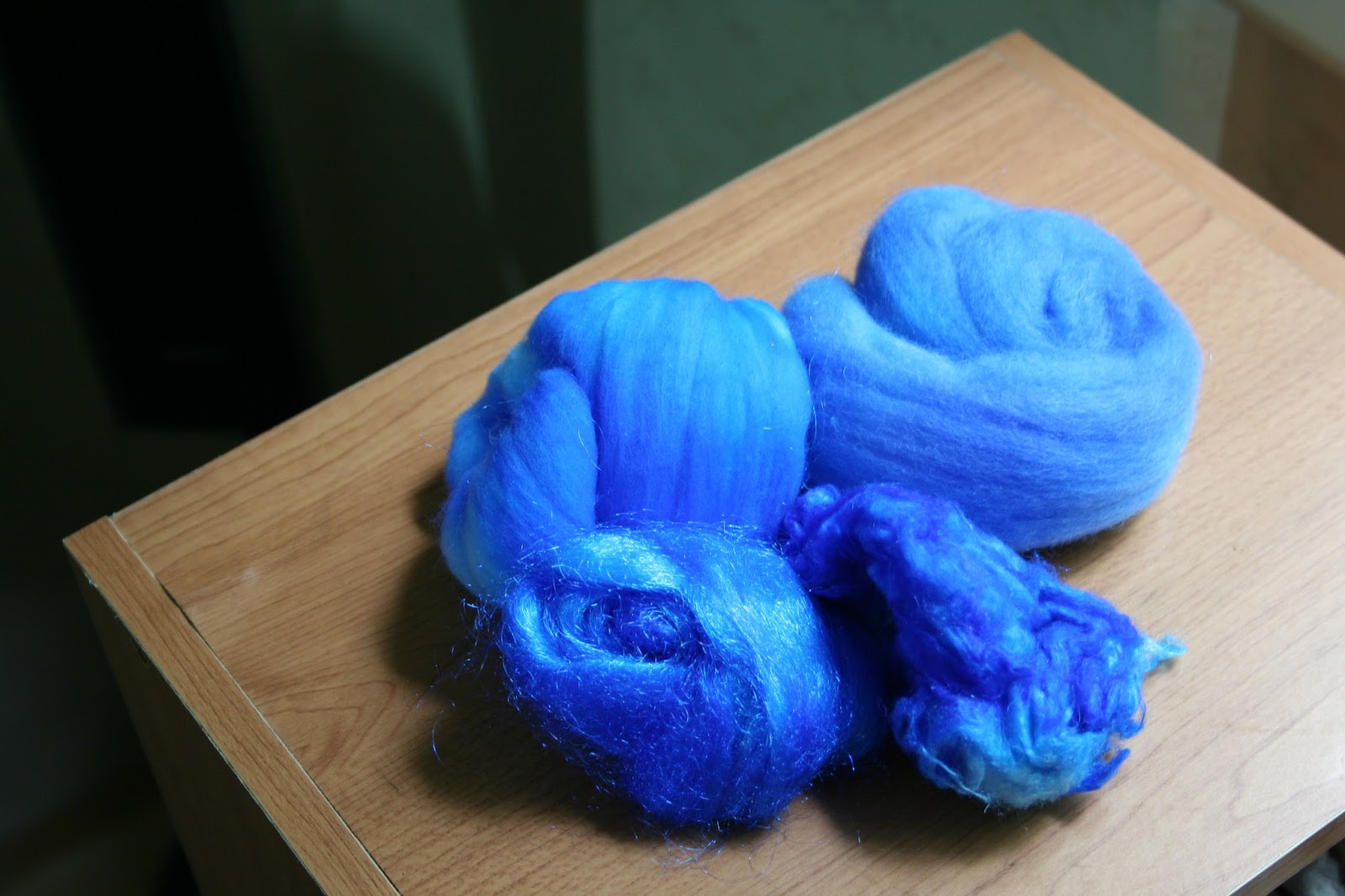So, let's do the big reveal now. Keep in mind that these are just my opinions and personal experiences, and do not reflect the results of the entire dyeing community. I may have received a bad batch of dye or I'm just not using them the way that others do. Brand 1 is Atul Colors from India.
 |
| Brand 1: Atul Colors |
This particular dye brand gave me the primary colors I would expect, and reminded me of an elementary school. They dyed the fibers very well, but I was a little disappointed that the merino didn't take the dye as well as the BFL. The second biggest issue I had with this dye company was that the red dye solution was goopy and the black dye left large specks of coagulated dye in the dyebath after it was done dyeing. Again, this dye may not have liked being in a solution, so perhaps it would have worked out better if I just used the dye as powder instead. In regards to the merino problem, I might try dyeing only merino to verify that it just fixes the dye more slowly than the BFL. This difference in rate of color fixing is important to know, and now if I dye a BFL/merino blend batt, I will probably get two different shades of the same color--you could really have fun with this, and if it's predictable, you can dye the two different shades of one color in the same dyebath. That would save you some time and effort!
 |
| Brand 2: Sandos Colors |
Brand 2 is Sandos Colors from India. Aside from my problems with the yellow dye not forming a solution, this brand dyed very well. I loved how the blue turned out, and it was very different than the blue from Brand 1. Since it was so different, it gave me lots of ideas for combing colors, and probably would have produced beautiful tropical colors instead of the 'regular' ones (think about normal Starbursts versus tropical Startbursts). It may very well be worth requesting for new yellow dye from this company and trying it again without making a solution first. If this brand's yellow is finicky, I might be able to deal with it to see how the yellow color turns out on the fiber. This brand was an extremely close second out of the three I tested. I might just buy the blue from this brand because I love it so much!
 |
| Brand 3: Miyakozome Acid Dyes (wool and silk) |
 |
| Brand 3: Miyakozome Acid Dyes (cellulose) |
Brand 3 is Miyakozome Acid Dyes from Japan. These were the dyes I was most pleased with using. Given their lack of problems and great coverage, they were the reason I swooned for Brand 3. I talk at length about why I think this brand can dye both wool/silk and plant fibers in my review of Brand 3. I don't really have many cons to say about this brand, except that I think it may be the most expensive brand out of the three I tested. In this case, I think the higher price tag makes the hassle-free dyeing experience even better for me.
Would I ever use Brand 1 or 2? The short answer is yes. Though I experienced some problems with those dyes, it doesn't mean the whole brand is awful or worthless. Some of the dye powders might require more attention, and I may have to substitute colors of one brand to use with a different brand. The dyes from India are very inexpensive, so it may be worth it to buy cheaper dyes and mix and match colors to get the results I want. If I'm a hobby dyer and only dye 6 weeks out of the year during the summer, these will probably fit my requirements easily.
Brand 3 is a clear winner when it comes to the consistency of the dye solutions and the ease of dyeing, but the yellow and blue aren't as nice as the colors of Brand 1 and 2, respectively. At some point in the future, I'll probably buy the blue from Brand 2 because I think it has a lot of potential in creating fun colorways. Even though I'm going to choose Brand 3 as my primary dye company, I will by no means forget the great colors I got from Brands 1 and 2.
Thank you to everyone who has followed these testing experiments over the last several months. I wish I could have worked on them at a faster pace, but life happens. If this has inspired you to do some testing on your own, and especially if you decide to do things differently, post your own results in the comments below, or post them to Facebook so we can all learn something new.
No comments:
Post a Comment